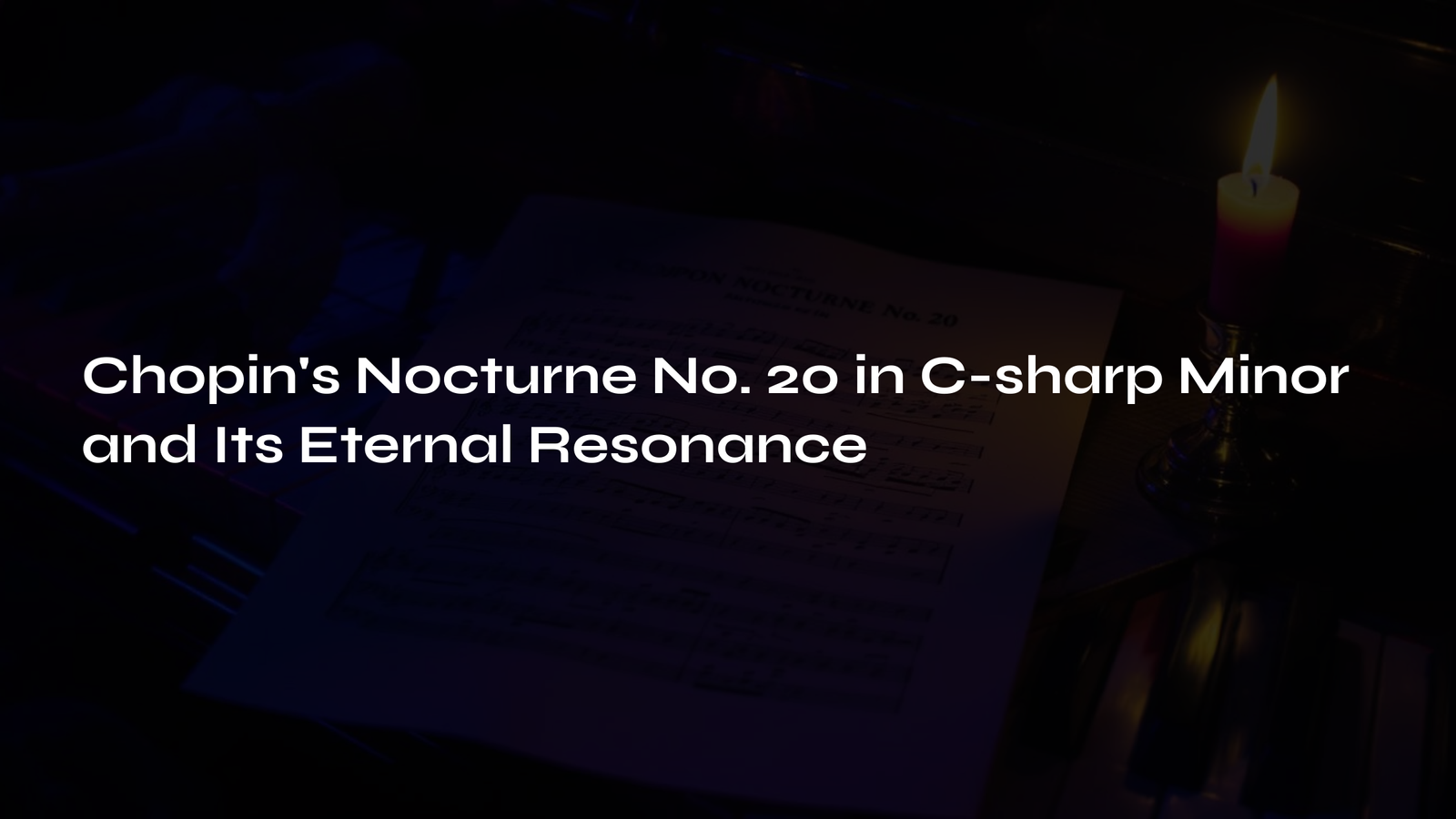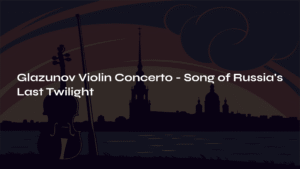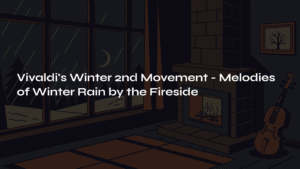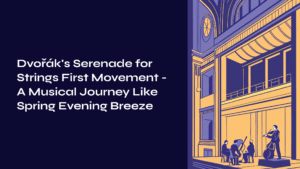Table of Contents
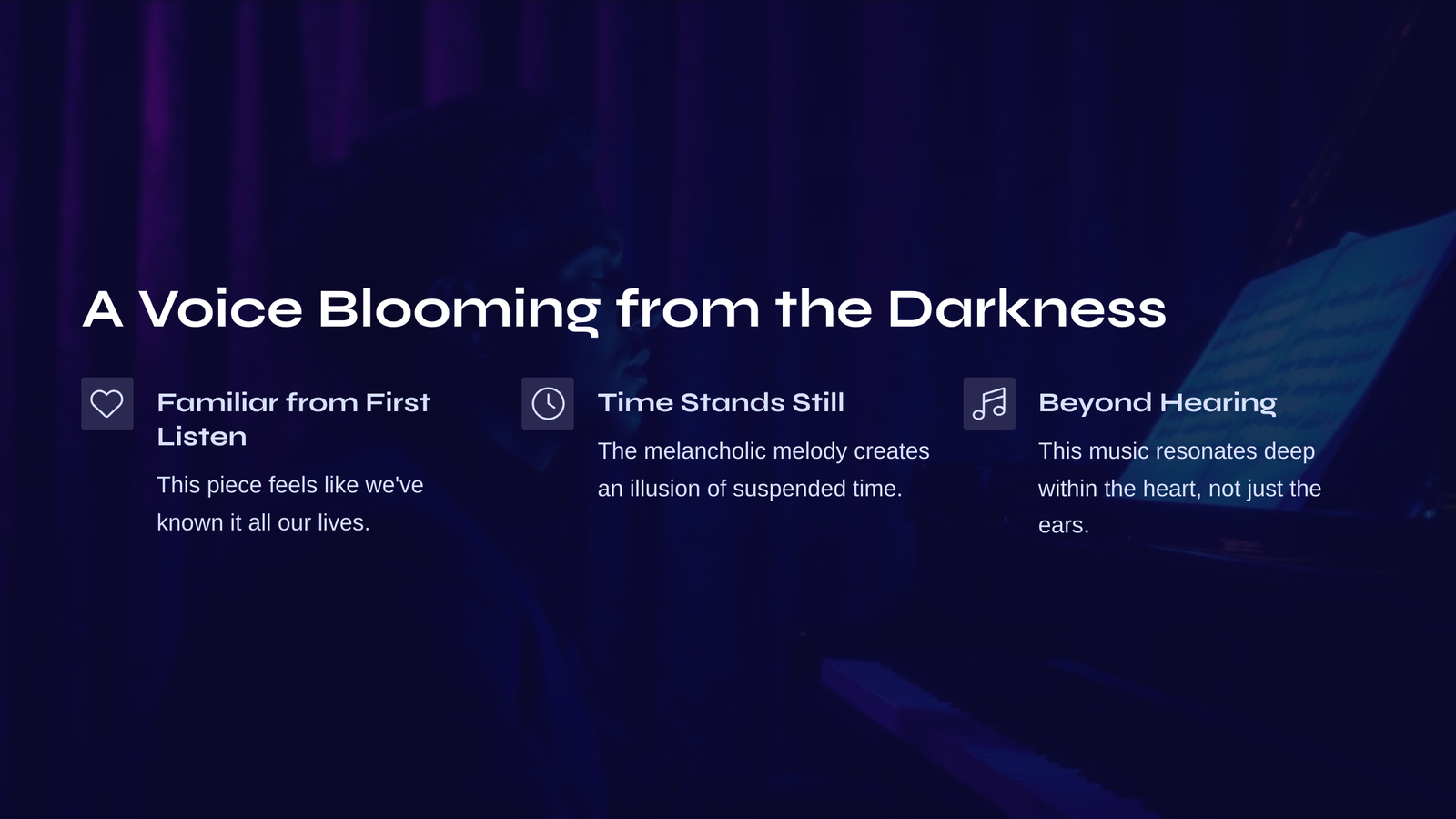
A Voice Blooming from the Darkness
Some music feels familiar from the very first listen, as if we’ve known it all our lives. Chopin’s Nocturne No. 20 in C-sharp minor is precisely such a piece. From the first note born upon the piano keys, it penetrates deep into our hearts like someone whispering quietly in the darkness.
When listening to this piece, I fall into the illusion that time has stopped. The melancholic yet beautiful melody floats through the air, touching fragments of memories each of us carries within. Have you ever experienced such a moment? When music isn’t simply heard by the ears, but resonates somewhere deep within the heart?

The Landscape of Young Chopin’s Heart
In 1830, when twenty-year-old Frédéric Chopin composed this piece in Warsaw, he had not yet left his homeland. This nocturne was dedicated to his older sister Ludwika, with the humble inscription “as an exercise before beginning the study of my second Concerto.” But could Chopin have known then that this modest “exercise” would become one of the most beloved nocturnes in classical music history?
Chopin hesitated to publish this work at the time because it borrowed melodies from his Piano Concerto No. 2, feeling it wasn’t entirely original. Yet sometimes there exists a power in music that transcends the composer’s intentions. This piece is exactly such a case.
The work saw the light of day in 1875, twenty-six years after Chopin’s death. Like wine that must age to reach perfection, perhaps this music too was waiting for its proper moment?
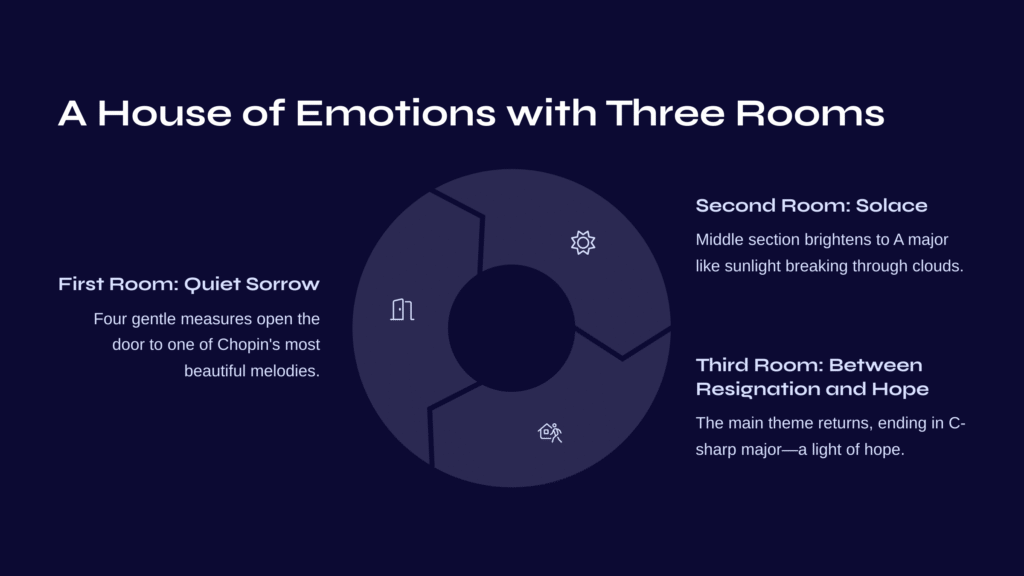
A House of Emotions with Three Rooms
This nocturne follows an A-B-A ternary form, like a house of emotions containing three distinct rooms.
The First Room – A Space of Quiet Sorrow
The piece begins with four measures of gentle introduction, like someone carefully opening a door, or breaking silence for the first time after a long pause. The main theme that emerges in measure 5 represents one of Chopin’s most beautiful melodies.
Listening to this melody feels like someone singing in the darkness. The left hand’s arpeggiated accompaniment seems to express time flowing endlessly by. Like water drops falling one by one, or a heart beating quietly. The right hand melody flowing above sounds sometimes like a sigh, sometimes like a prayer.
The Second Room – A Moment of Solace
The middle section beginning at measure 21 is like sunlight breaking through clouds. As the music modulates to A major, it suddenly brightens. The warmth of the major key temporarily dispels the darkness of the minor, and more ornate, decorative melodies begin to dance.
This section feels like a flashback to happier times within a sad story, or perhaps like a beautiful landscape encountered in a dream. The notes flutter like butterflies, momentarily liberating us from heavy reality.
The Third Room – Between Resignation and Hope
The final section, where the main theme returns, is the same yet different. The same melody, but containing deeper reflection. Like a person returning home after a long journey, viewing the same landscape with different eyes and a changed heart.
At the piece’s conclusion, Chopin leaves us a small gift. The work that began in C-sharp minor ends in C-sharp major—like a herald of spring arriving at winter’s end, like a light of hope blooming at despair’s edge.
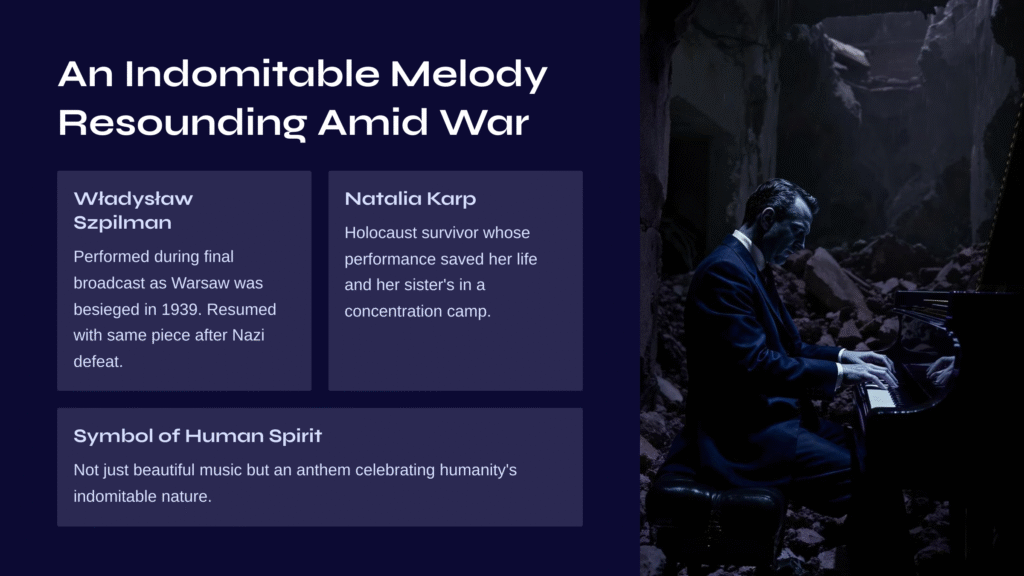
An Indomitable Melody Resounding Amid War
This piece transcended mere beautiful music to become a historical symbol due to twentieth-century tragic events. On September 23, 1939, Polish pianist Władysław Szpilman performed this piece during the final live broadcast of Polish Radio as Warsaw was besieged by German forces. Though the performance was cut short when German bombing destroyed the power supply, six years later, when the Nazis were defeated, he resumed broadcasting with the same piece.
Another story exists as well. Holocaust survivor Natalia Karp performed this piece on concentration camp commandant Amon Göth’s birthday, saving both her own life and her sister’s. It’s a moving testament to how music can preserve humanity even in the most desperate circumstances.
Knowing these stories changes how we hear this piece. It becomes not simply a beautiful melody, but an anthem celebrating the indomitable nature of the human spirit.
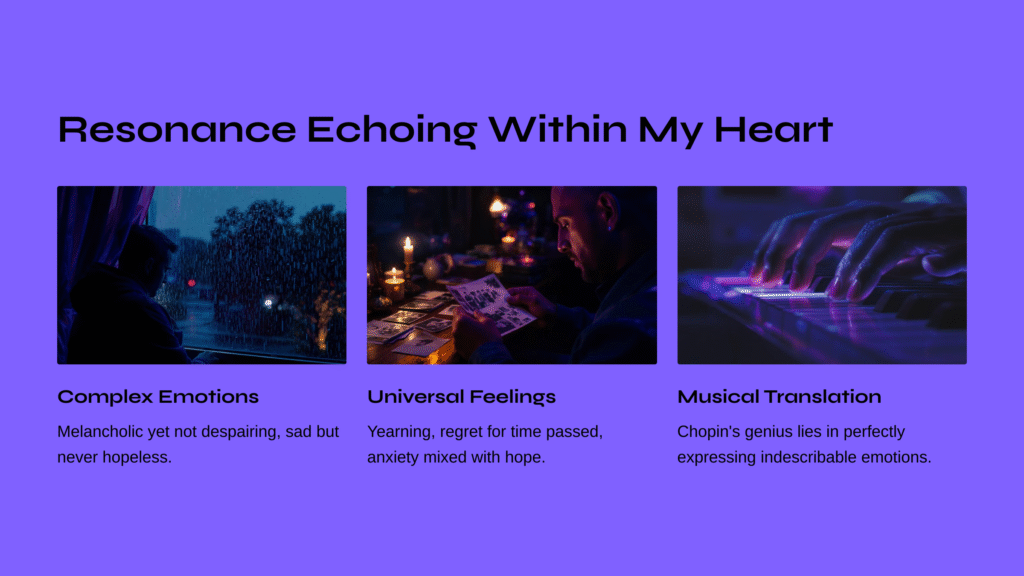
Resonance Echoing Within My Heart
Each time I listen to this piece, I’m captured by a peculiar feeling. Melancholic yet not despairing, sad but never hopeless—emotions similar to those complex, subtle feelings experienced while sitting by a window on a rainy day, watching raindrops fall.
This piece contains universal emotions—feelings everyone has likely experienced at least once. The heart that yearns for a loved one, regret for time passed, the complex mixture of anxiety and hope regarding an uncertain future.
Chopin’s genius lies precisely in his perfect musical translation of such indescribable emotions. That’s why listening to this piece makes everyone recall their own stories. Music meets individual experience to create new meaning.
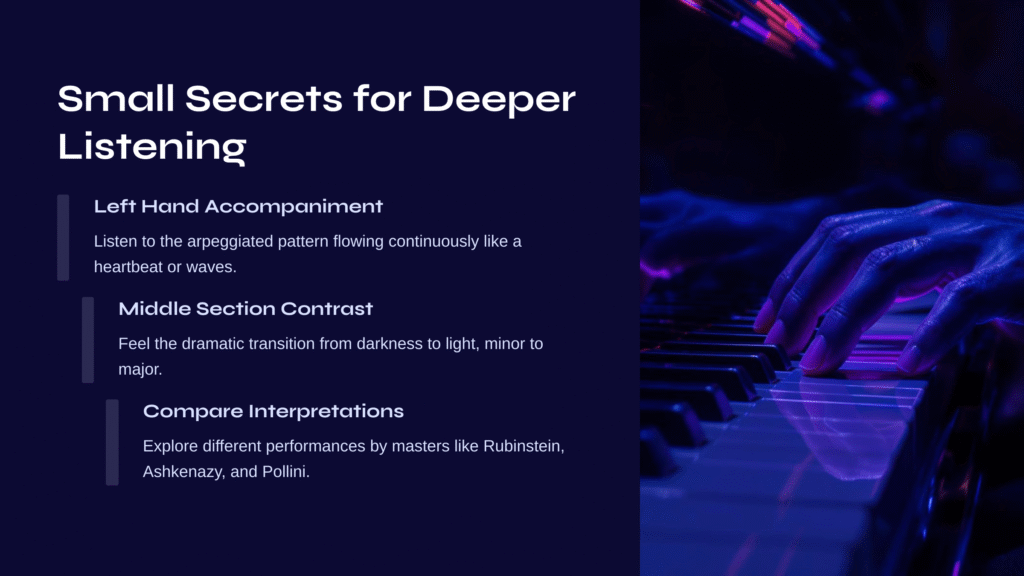
Small Secrets for Deeper Listening
If you wish to appreciate this piece more deeply, I recommend paying attention to several elements.
First, listen carefully to the left hand’s arpeggiated accompaniment. Though seemingly simple, this accompaniment pattern determines the entire piece’s atmosphere. It flows continuously like a heartbeat, or like waves endlessly striking the shore. This sustained movement makes the melody above shine even brighter.
Second, notice the contrast in the middle section. Feel how dramatic the transition is from darkness to light, from minor to major. And observe that subtle sense of relief when returning to darkness again.
Third, compare interpretations by various performers. This piece gives completely different impressions depending on the performer. Some performances are more lyrical, others more dramatic. Listening to masters like Rubinstein, Ashkenazy, and Pollini reveals how diversely the same piece can be interpreted.
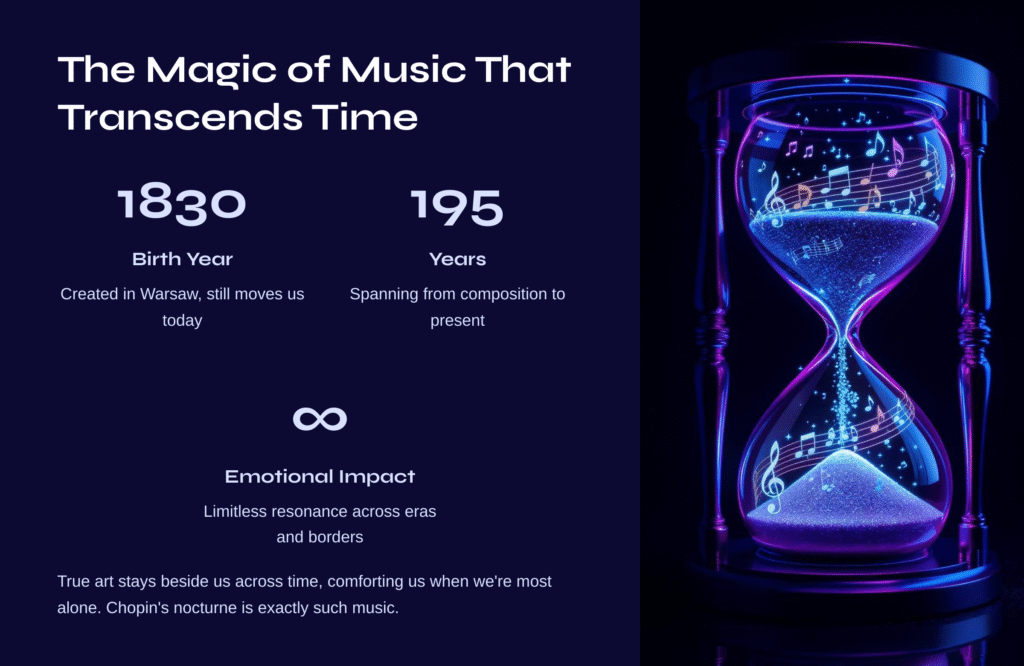
The Magic of Music That Transcends Time
Ultimately, the greatest gift this piece offers us is a transcendent experience of time. The fact that this music, born in 1830 Warsaw, still approaches us with vivid immediacy in 2025, and will continue to do so in the future.
Each time I listen to Chopin’s Nocturne No. 20, I reaffirm music’s mysterious power. How can these few minutes of music move our hearts so deeply? How can it resonate in everyone’s chest across eras and borders?
Finishing this journey that begins in darkness and ends with hope’s light, I think once again: perhaps true art is that which stays beside us across time, comforting us most closely when we’re most alone. Chopin’s small nocturne is exactly such music.
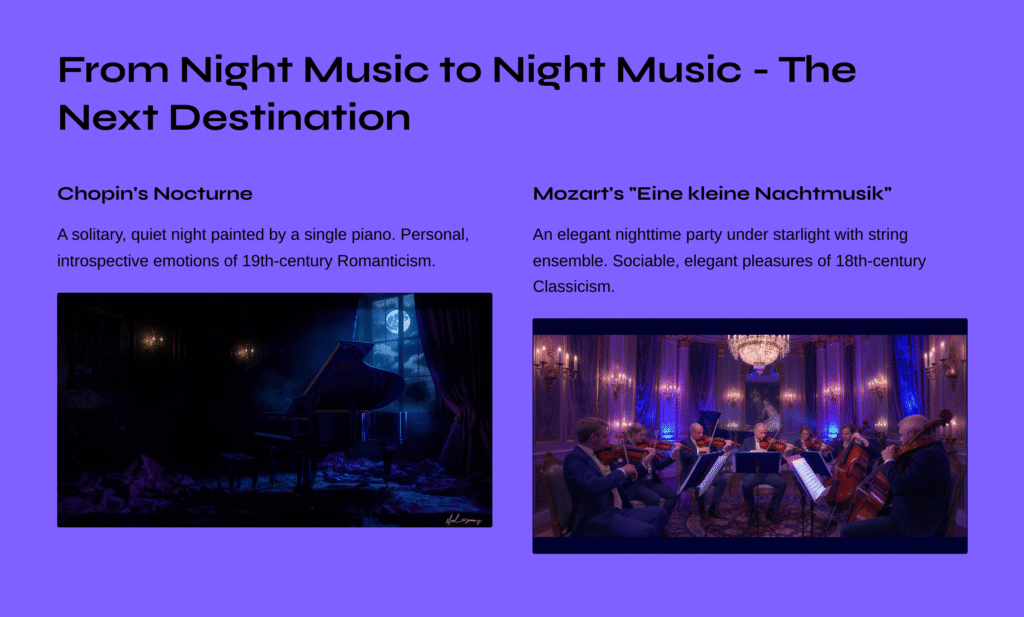
From Night Music to Night Music – The Next Destination
After listening to Chopin’s intimate nocturne, wouldn’t you like to experience music that deals with the same “night” yet possesses a completely different atmosphere? I recommend Mozart’s “Eine kleine Nachtmusik” (A Little Night Music).
If Chopin’s nocturne painted a solitary, quiet night, Mozart’s serenade evokes an elegant nighttime party unfolding under starlight. One is a monologue whispered by a single piano, the other a brilliant conversation created together by string ensemble.
Both are “night” music, but where Chopin explored personal, introspective emotions, Mozart celebrates the sociable, elegant pleasures of evening. From melancholy to grace, from solitude to society, it would be a time journey from 19th-century Romanticism to 18th-century Classicism.
Let Mozart’s clear beauty refresh hearts that have been immersed in Chopin’s deep emotions. Through music, you can discover how the same night can possess such different colors.
